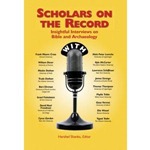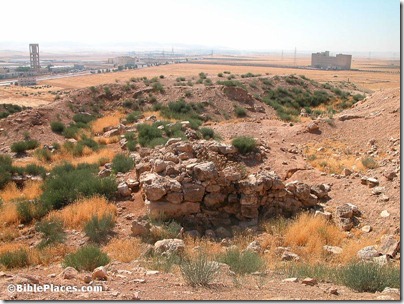I always enjoy reading stories of early explorers in the land of Israel as well as personal accounts of excavation experiences. A little book of essays written by Paul W. Lapp is still in print 35 years later and for good reason. The Tale of the Tell begins with several chapters introducing the nature of archaeology in a clear and concise manner, and the rest of the book contains brief accounts of Lapp’s work at other sites in Israel and Jordan, including Wadi ed-Daliyeh, Gibeah (Tell el-Ful), Taanach, and Bab edh-Dhra. The final chapter describes his work at a site that he believed was biblical Ramoth Gilead. The introduction to his excavations is interesting for a number of reasons, including the daily schedule, the future archaeologists on staff, and other personal details. Lapp writes:
“The winter of 1967 was an unusually cold and wet season in Jerusalem, and it reached its climax in the form of a blizzard on Easter Sunday, March 26. The Rumeith dig was scheduled to get underway on the first day of April, but there was some doubt whether the inclement weather would allow us to comply with our plans. We were fortunate to have some ideal weather right after Easter, so on  March 30 the first contingent headed for Rumeith, and on the following day the rest of the staff followed with equal enthusiasm. The 1967 campaign took place between April 1 and May 12, a period of six weeks on a five-day week basis.
March 30 the first contingent headed for Rumeith, and on the following day the rest of the staff followed with equal enthusiasm. The 1967 campaign took place between April 1 and May 12, a period of six weeks on a five-day week basis.
Out of deference to our Moslem workers we observed the weekly holiday on Friday; out of consideration for the staff Saturday was also included. At the end of the work-day each Thursday the staff wasted no time as they hurried to Jerusalem to re-enter civilization at the American School in the form of a bath and a change of clothes. After being sandblasted for several days each week on the wind-swept mound, the latter were very much in order.
“The Rumeith expedition was jointly sponsored by Pittsburgh Theological Seminary and the American Schools of Oriental Research. The budget was provided by the former, and the equipment and transportation by the latter. The staff was composed of the following: Howard M. Jamieson, who represented the Pittsburgh Seminary as codirector and also functioned as treasurer and field supervisor; Susan E. Culp of the University of Pennsylvania, anthropologist and field supervisor; Gavriel Flores, C.SS.R., a Brazilian and student at the Ecole Biblique, field supervisor; also Gustav Jeeninga from Anderson College, Indiana, Edward D. Grohman from Knoxville College, Tennessee, Philip J. King from St. John Seminary, Boston, Robert A. Hutchison from St. Charles, Illinois, and Walter E. Rast from Valparaiso University, Indiana, field supervisors; Thomas Schaub, O.P., from the Ecole Biblique and Aquinas Institute in Dubuque, architect; Fouad Zoghbi of Bethlehem, draftsman; Issa Zoghbi, Bethlehem, assistant draftsman; Aletta Jeeninga of Anderson, registrar; Sister Marie McNamara of Rosary College, River Forest, Illinois, pottery mending; Ahmed Odeh, representative of the Jordan Department of Antiquities. The service staff included Aboud Dhib Nasif as driver and camp manager; Kamel Ikhdayir as cook with two assistants; and Nasir Dhiab as chief technical man with eight assistants from Taanach, Samaria, Balatah, and Bab edh-Dhra’. The staff was very dedicated and worked together in a spirit of warm friendship and good humor.
“The days and weeks spent at Tell er-Rumeith were busy ones. The day began shortly after six o’clock when there would be a great rush to the water storage tank to fill a basin with cold water for the morning ablutions. Breakfast was served shortly thereafter, and it consisted of hot cereal, eggs, bread, and coffee. This was more than adequate preparation for a full day’s work. The workers began to arrive from Ramtha during our breakfast period, which meant that they were well ahead of the seven o’clock roll-call.”
The continuation of the account will be posted tomorrow.


